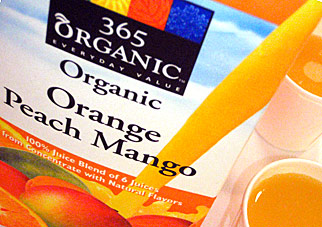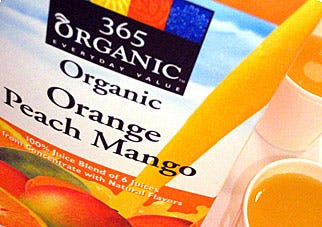March 11, 2015


Whole Foods organic orange juice
Whole Foods Market announced results from its annual Food Shopping Trends Tracker survey conducted online in June by Harris Interactive, which found that organic foods are making a larger impact in consumers’ shopping choices in 2010. While about three out of four adults continue to purchase natural and/or organic foods (75% in ‘10 and 73% ‘09), the number of organic products found in their grocery basket has increased. Notably, 27 percent of adults say that natural and/or organic foods comprise more than a quarter of their total food purchases this year, up from just 20 percent a year ago.
Celebrating its 30th anniversary in September, Whole Foods Market also surveyed Baby Boomers online in June (via Harris Interactive) about food attitudes and purchasing habits today compared to three decades ago. More than four-fifths of adults say they are now more concerned with what foods they eat (84%), they read nutrition labels more closely today (84%) and have a better understanding of how their food is produced (83%) than they did in 1980.
“There has been a sea change these past 30 years in shopper attitudes toward food with a growing appetite for information on how and where food is produced to what’s in the food and how it impacts health,” says Michael Besancon, Senior Global Vice President of Purchasing, Distribution & Marketing for Whole Foods Market. “Looking to the future, Whole Foods Market will continue to be a trusted source for our shoppers who are asking more questions about food while striving to eat healthier.”
For a snapshot of how food buying habits have changed over the past 30 years, Whole Foods Market asked Boomers to rank the top items nearly always in the pantry/refrigerator in 1980 compared to today.
In 1980, the top five items were:
* Milk (89%)
* Canned or frozen vegetables (83%)
* White bread (74%)
* Soda/pop (74%)
* Iceberg lettuce (66%)
In 2010, the top five items are:
* Fresh fruit (83%)
* Milk (82%)
* Fresh vegetables (79%)
* Wheat or whole-grain bread (77%)
* Canned or frozen vegetables (69%)
Comparing the two time periods, spring or mixed lettuces show the highest increase in popularity today among Boomers (59% currently vs. 14% 30 years ago), followed by wheat or whole-grain bread (77% currently vs. 34% thirty years ago), and whole grain cereal with little or no sugar (66% today vs. 26% thirty years ago). Rounding out the top 10 list of food items that grew in popularity among Boomers over the past 30 years are food supplements, fresh fruit, specialty beverages like gourmet coffees and flavored teas, fresh vegetables, fresh-prepared entrees, salads and/or sides, ethnic foods and/or ingredients, and store brands.
Conversely, sugary cereal shows the largest decline in popularity among Boomers (63% 30 years ago vs. just 19% today), closely followed by white bread (74% 30 years ago vs. 31% today).
Most Boomers report they are now more concerned about fat (74%), cholesterol (74%) and added growth hormones and antibiotics in meat and dairy products (70%) than in 1980.
More than half (54%) of Boomers say they buy more organic and/or natural foods today. This finding is in line with findings from the Whole Foods Market Food Shopping Trends Tracker survey that show an increase in adults who say if prices are comparable they prefer to buy natural and/or organic foods over conventional foods (73%), and they would like to find ways to be able to buy natural and/or organic foods within their budget (72%), both experiencing a significant 7-point increase from last year’s findings.
Most adults say current food prices continue to impact how they shop for groceries (84%), and the economy has impacted their cooking and eating habits (77%). Specifically, they are eating dinner at home more often and eating out less (59%) and are budgeting food shopping trips more strictly (42%). Of those adults who indicated that current food prices have affected their grocery shopping 46% say they go out of their way to look for lower-cost items, 56% say they prepare more meals at home, and 26% plan meals for the week and buy only what they need for that week.
“While the economic downturn has brought renewed attention to getting more value for less money, it is encouraging to see that shoppers don’t want to cut corners on healthy, high quality food,” says Besancon. The survey found, regardless of current food prices, the majority (72%) of adults say they don’t want to compromise on the quality of the food they buy.
SOURCE: Whole Foods Market
Photo by Oomni
.
About the Author(s)
You May Also Like


